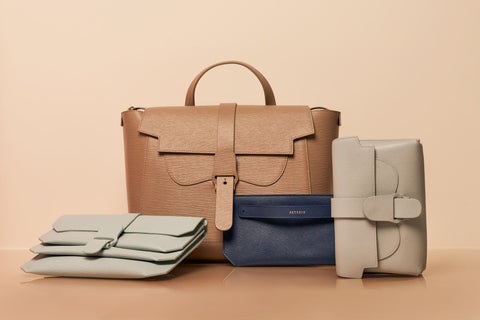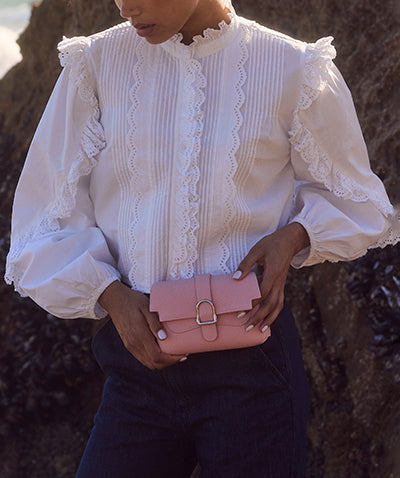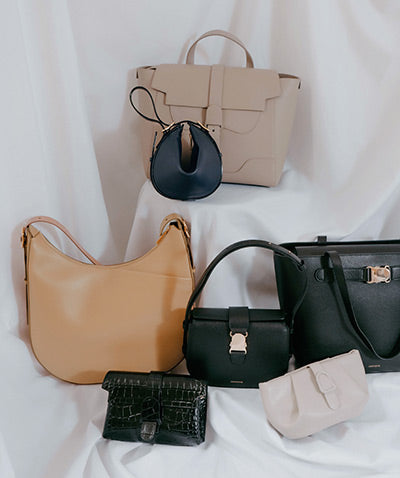Gift Note Edit
${ cartNote }
${ GWbtnTxt() }
Add offer code at checkout.
Shipping
Free
Subtotal
${ formatMoney(cart.total_price) }
Due Today
$0


See details.
How to Store Handbags: Do's and Don'ts & Storage Options
The SENREVE woman's handbag is a reflection of her own personal style and beauty - it's an investment she makes in herself that helps her share her personality with the world. The handbag is an essential part of her wardrobe and should be cared for with the same love and attention she gives her Louboutins.
Why, then, do we so often find ourselves shoving that investment carelessly to the back of the closet when it's not in use? Like anything else, handbags require a specific level of care that is necessary to keep them in top-notch condition for years to come.
Read on to learn more about the do's and don't of caring for and storing your handbag.
Quick Do’s and Don’t of Handbag Storage:
Do's:
- - Always handle your purse with clean hands to avoid transferring germs and oils.
- - Make sure the zipper is fastened and let the handles overlap on top of the closure.
- - Make any handbag repairs well in advance of storage.
- - Use a microfiber cloth when wiping down your bag as other materials can cause scuffs to the delicate material.
- - Apply a leather conditioner in advance (typically, a leather conditioner should be applied about once a year).
- - Make sure all of the metal parts of your bag stay in good condition by using a damp microfiber cloth to wipe everything down.
- - Use a dehumidifier in the area you plan to store your bags. This will ensure no moisture is in the air.
- - Rotate your handbags from time to time to make sure the leather is not folding or bending into a permanent shape.
Don'ts:
- - Never put your handbag on the floor, even if it's carpet--the floor has germs, bugs, and moisture that can damage the leather.
- - Do not overclean your bag. We recommend giving your bag a thorough cleaning every six months.
- - Never store your handbag without a cover or inside support. A lack of support can cause your bag to become permanently misshapen.
- - Do not use chemicals to clean your bag, regardless of the material. Most manufacturers recommend that leather handbags are cleaned using only water and a microfiber towel.
- - Do not keep your bag near extreme temperature or in direct sunlight, as this can cause direct damage to the material, especially leather.
- - Do not store your bag anywhere that moisture is present (like in your basement), which could promote fungal growth while causing damage.
- - Do not store your handbag in a covered plastic sheet as the plastic may react with the leather, causing damage over time.
General Handbag Storage Options
Whether you store your bags out in the open, or tucked away, there are few options for organizing that will help keep them away from dust and pests so that they maintain a pristine condition for years to come.

No matter how you plan to store your bag, making sure it keeps its shape is of utmost importance, as mentioned above. Any bag you plan to store should be filled with tissue paper, old t-shirts, folded towels, or anything else that will help it maintain its natural shape. Without this, you run the risk of deflating or ruining a bag that has been sitting in a bent position for too long. Here are a few storage options:
1. On open shelving
This is the simplest way to store your handbags, by simply lining them up on overhead shelves. While it may be intuitive to store upright, store your SENREVE handbag on its back. For added organization, add acrylic dividers between the purses. Place the bags you use the least often on the highest shelf while reserving a lower shelf for the bags you interchange more frequently.
2. Using clear divider boxes or cubbies
like these or even these, depending on what fits best in your closet. These are a great option if you have limited shelving and are easily stackable/movable to other locations. If you find plastic divider boxes that are enclosed, these can be a great option for under the bed storage as well.
3. On a DIY purse rack
This can be done by turning an old bookshelf into its own purse cubby, with hooks for tote bags and shelves for clutches or wallets.
4. Using door hooks or over the door wire baskets
While over the door wire baskets and hooks can be tempting, this is one common storage method we do not recommend as it can put unnecessary prolonged pressure on the handles of your bag.
Storage by Purse Type
Clutch bags
Because of their smaller size, clutch bags can easily be stored in plastic shoe containers, on a makeshift bookshelf, or even in hanging shoe bags. This makes it easy for each clutch to have its own storage compartment.
Shoulder bags
Shoulder bags can be stacked flat on top of each other on a shelf, propped upright in a line.
Wallets and smaller clutches
Given their smaller nature, magazine holders are a great option that create space while keeping items upright and flat.
Prepping your Handbag for Storage
Even if you only wear your bag once per year, getting into the habit of practicing proper prepping techniques before storage is an important process in ensuring your bag lives a long and healthy life. Follow these steps to properly prep your bag for its time on the shelf.
1. Clean and Condition
This is the most important step in the prepping process and should be done before anything else.
For handbags made of real leather, vegan leather, or plant-based materials, we recommend taking a simple approach to cleaning by using a microfiber cloth and water to gently wipe down the inside and outside of the bag.

For light cleaning our leather, we recommend washing your bag with a cloth that is damp with warm water. You can also spot clean your SENREVE handbag with a leather cleaner, which can be purchased at a drugstore or cobbler. Be sure to test products before applying to the whole bag.
Please avoid using wipes that have chemicals in them (such as baby wipes or Clorox wipes), as this will ruin the leather. If you’d rather leave it to the professionals, a cobbler or other leather professional can deep clean your bag. Even if you are spot cleaning, we recommend spot testing in an inconspicuous spot beforehand. Always follow the manufacturer's instructions.
When cleaning suede, we recommend only having a professional perform any cleaning.
To preserve the quality and beauty of the Italian suede, we recommend:
- - Keeping the product in its dust bag when not in use
- - Avoiding contact of light suede with dark clothing and vice versa to reduce possibility of color transfer
- - Avoiding contact of suede with liquid, water, alcohol or oils
- - Avoiding exposure to direct sunlight
- - Avoiding contact with rough or abrasive surfaces
Fabric handbags are a little trickier to clean at home. In most cases, a cloth won't do the trick, and professional cleaning services are likely required. Some experts suggest a soft toothbrush and mild detergent can work, but we would rather not take that risk and advise professional cleaning instead.
After all cleaning and/or spot treatment is complete, it's time to condition your bag. Leather lotion and leather conditioner are the best options as they contain trace amounts of oil and wax that provide moisture and add shine to your leather handbags. To use, apply a small amount to a clean microfiber cloth and buff in small circles across the full surface area of the bag. This will help keep the leather supple over time. Proper application is important, so be sure to follow any manufacturer instructions. For suede and fabric, we do not recommend using any type of conditioning agent.
2. Air Dry
Now that your bag is properly cleaned and conditioned, the next step is to let the bag fully air dry on both the inside and outside. We recommend leaving your handbag open for 6-8 hours to make sure it is completely dry. Storing a bag that is damp or still contains any moisture can lead to bacteria growth and even color transfer. Do not dry your bag using any type of applied heat, as this will cause damage to the material. Rather, let your bag dry naturally or by using a fan.
3. Stuff and Cover
The last step before storage is to make sure your bag is properly shaped, stuffed, and zipped. While this is a step that might be easy to overlook, it's important in order for the bag to maintain its original structure. Do not overstuff the bag, as this could cause it to stretch and become distorted. If the bag is understuffed, you risk causing permanent dents and wrinkles. After stuffing, you now have the option to invest in a dust cover for your bag, though SENREVE handbags will always come with their own dust bag for optimal care.
In general, handbags that are continuously exposed to natural and artificial light have a tendency to discolor over time. At the same time, leather oxidizes naturally. Using a dust cover can help alleviate the risk of both.
Bottom Line
If you love handbags as much as we do, then you know caring for your handbag is not something you should take lightly. We put our bags through wear and tear in their everyday use and, at the end of the day, they need occasional love and attention to stay pristine. Getting into the routine of taking proper care of your bag now will ensure your investment lives on for many years. If you're curious to explore our diverse selection of handbags, shoulder bags, and belt bags, check out our bag bestsellers here.

